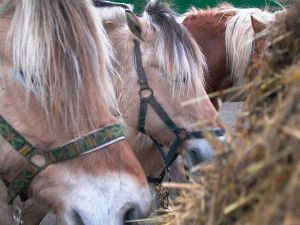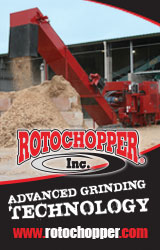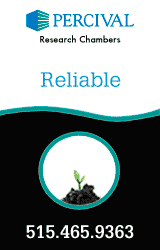From By-product to Power: The business of turning manure into renewable energy
 When thinking of horses, renewable energy likely isn’t the first thing that comes to mind. But, over time, the potential connection between animals and energy has become obvious. Back in the late 1800s, the horse population skyrocketed in America and around the world due to the explosion of trade and industrial freight, personal and public transportation, and increased farming acreage.
When thinking of horses, renewable energy likely isn’t the first thing that comes to mind. But, over time, the potential connection between animals and energy has become obvious. Back in the late 1800s, the horse population skyrocketed in America and around the world due to the explosion of trade and industrial freight, personal and public transportation, and increased farming acreage.
All of this “horse power” created mounds…and mounds…of horse manure. Beyond the obvious issue of odor, additional environmental concerns stemmed from the unwanted byproduct, including flies and disease, public sanitation issues, and even increased fatalities.
To solve the horse byproduct problem, urban planners and entrepreneurs of the day began to invest in new technologies and new modes of transportation. Slowly, over time, people relied less and less on the horses themselves, and more and more on automated “horsepower.”
What those pioneers didn’t predict, however, was the impact vehicles would have on our energy consumption and environment in other ways. Moreover, as the population increased, so did the need for dairy and meat. So, despite any decreases in horse manure throughout the city streets, mounds of manure were (and still are) an unsightly issue at dairy and meat farms.
As the saying goes, “What comes around goes around.” Entrepreneurs are again discussing manure, only this time they are using new technologies to turn the animal byproduct into energy—renewable energy.
The power of anaerobic digestion
Anaerobic digestion (AD) is the process by which organic materials (such as manure) are broken down by micro-organisms, in the absence of oxygen. Used to manage waste, anaerobic digestion can also be used to produce fuels. The usage of animal waste for AD solves two environmental issues: disposing of billions of pounds of manure, and creating a high-quality renewable source of energy.
Currently, the largest AD facility in North America is at the Huckabay Ridge Anaerobic Digestion Project in Stephenville, Texas. Located in a major dairy community where manure is plentiful, the Huckabay Ridge facility turns manure and substrate (including glycerin, grease trap, and other organic waste) into biomethane gas (methane, carbon dioxide, and hydrogen sulfide), as well as fertilizer through microbial co-digestion.
During a multi-stage digestion process, the substrate provides most of the carbon needed for biomethane production, while the manure provides pH, alkalinity, and buffer capacity to maintain biological stability. The facility has eight massive, continuously stirred tank reactors, referred to as digesters, with a total working volume of 6.8 million gallons.
Once digestion is complete, the resulting biomethane is piped to an onsite processing plant where carbon dioxide, hydrogen sulfide, and water are removed. The end product is clean, high-quality renewable natural gas, which is piped to an intrastate pipeline, sold, and delivered to a large California utility.
Huckabay Ridge currently processes about 12,500 tons of manure and 14.6 million gallons of substrate per year—waste that would otherwise be dumped in unsustainable destinations, such as in landfills.
Through sustainable use of the waste, this facility has taken upon itself to help reduce greenhouse gas emissions, minimizes adverse impacts on local watersheds, and produces liquid and solid fertilizer to promote crop growth.
Changes for the future
Although today’s urban planners and investors are still dealing with many of the same issues as their predecessors 100 years ago, the results are different, offering promise for the future. Innovative technologies, such as anaerobic digestion, have created more environmentally friendly opportunities to dispose of the mounting collection of waste and animal byproducts.
The Huckabay Ridge Anaerobic Digestion Project is merely one example of the positive impact AD technology can offer, but there are various, similar waste-to-energy plants popping up throughout the US as a means of turning waste into power.
From horses to dairy cows, it’s pretty impressive that the resulting animal byproducts could be transformed into clean, renewable, natural gasses that can serve to power our communities.
Maas Companies, Inc.
www.maascompanies.com
<Sidebar>
Fast facts
According to the United States Environmental Protection Agency (www.epa.gov), some benefits of anaerobic digestion (AD) include:
- The creation of biogas, a renewable source of energy that can be used similar to natural gas.
- A reduction in methane emissions—when left to waste, food and other organic materials (such as manure) decompose to create methane, a greenhouse gas with a global warming potential 21 times higher than carbon dioxide.
- Animal byproduct management. Dairy digesters, for example, provide a management method for manure that improves water quality, reduces methane emissions from manure lagoons and storage ponds, and minimizes odor.
- A reduction in chemical usage. Using the solid residual as a soil amendment can reduce the need for chemical fertilizers, improve plant growth, reduce soil erosion and nutrient run-off, alleviate soil compaction, and even help the soil retain water.
<Image caption>
Image 1. The Huckabay Ridge Anaerobic Digestion Project in Stephenville, Texas, is currently the largest anaerobic digestion plant in North America
Author: Michelle M Lantz
Volume: January/February 2014










